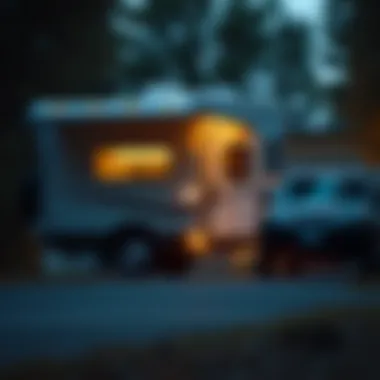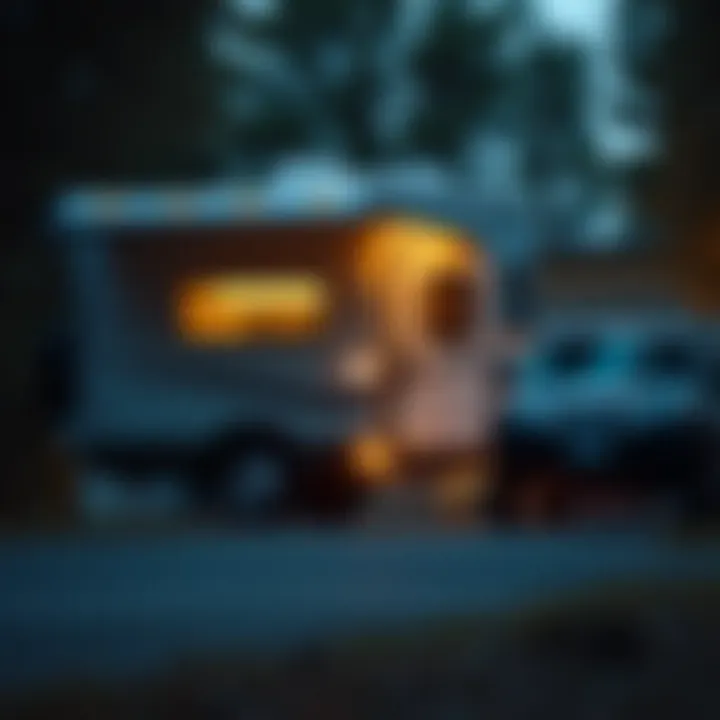Complete Guide to Mold Removal in Your RV


Intro
When one embarks on a journey in their recreational vehicle, the thrill of exploration is undeniable. However, along with the joy of the open road comes a lingering concern: mold. Often dismissed as an unsightly nuisance, mold can morph into a formidable adversary, threatening both health and the longevity of the vehicle itself. RV mold is more than just a cosmetic issue; it can lead to respiratory problems, allergic reactions, and a variety of other health concerns. That said, understanding the nuances of mold removal is crucial for every RV owner.
In this guide, we're diving into the nitty-gritty of tackling mold head-on. We'll explore the different types of mold that tend to cozy up in RVs, share tried-and-true cleaning methods, and provide preventive measures that can help keep mold at bay. Whether you’re a seasoned adventurer or a novice on the road, this thorough overview is tailored specifically for those who cherish their home on wheels.
Understanding Mold: A Primer
Mold thrives in damp and warm environments, making the nooks and crannies of an RV a perfect breeding ground. Common varieties, such as Aspergillus, Cladosporium, and Stachybotrys, each present their own sets of challenges.
- Aspergillus – Often found in decaying vegetation, this mold can adversely affect lung health.
- Cladosporium – Characterized by its dark-green or black color, this type loves to settle on surfaces within your RV.
- Stachybotrys – Commonly known as black mold, it’s perhaps the most notorious and feared type due to its potential health risks.
Awareness of these types is the first step to effective remediation. If left unchecked, what starts as a minor blemish can lead to significant decay in both the interior and structural integrity of your RV.
"The key to mold removal lies not only in eradication but also in understanding the foundations from which it grows."
In the sections that follow, we will delve deeply into how to remove mold, backed by strategies that have proven effective in maintaining a clean and safe RV environment. This comprehensive guide aims not only to alleviate existing mold problems but also to equip RV owners with the knowledge to prevent future growth. Let’s hit the road with confidence!
Understanding Mold in RVs
Mold is a persistent issue for RV owners as it can develop in any moisture-filled environment. Understanding mold in RVs is crucial not just for aesthetic reasons but also for health and safety. Mold can cause significant damage to both the interiors and exteriors of recreational vehicles. Moreover, RVs are often enclosed spaces with limited airflow, making them particularly susceptible. Addressing mold challenges starts with understanding how and why mold grows in these vehicles. This knowledge empowers RV owners to take appropriate preventive actions and cleaning methods to keep their vehicles safe and habitable.
What is Mold?
Mold is a type of fungus that thrives in humid environments, reproducing through tiny spores carried by air. It can grow on various surfaces, including wood, wallpaper, and even some fabrics. Essentially, if there's moisture and organic material, mold can settle in. In RVs, mold not only shows up as unsightly spots on the walls or upholstery but can proliferate behind surfaces, out of sight, causing rot and further issues. Understanding what mold is and its growth conditions is the first step in combating it effectively.
Types of Mold Commonly Found in RVs
Several species of mold can take hold within an RV, but a few are more prevalent than others. Getting familiar with these molds can help RV owners identify and address issues promptly.
Stachybotrys chartarum
Stachybotrys chartarum, commonly known as black mold, is notorious for its dark appearance and potential health hazards. It thrives in damp conditions, making it a significant worry for RVs, especially those stored in humid climates.
The key characteristic of Stachybotrys chartarum is its ability to release mycotoxins, which can adversely affect human health, including respiratory problems. This mold's unique feature lies in its potential for rapid growth once conditions are favorable. Consequently, immediate action is necessary when it’s detected, as its removal often involves thorough cleaning and sometimes professional intervention, making it a critical consideration in this guide.
Aspergillus
Aspergillus is another common type that may appear in RVs, often recognized by its fuzzy green or yellowish patches. What makes Aspergillus particularly concerning is its resilience; it can grow in various environments, often where there's stored food or wet materials.
Aspergillus is significant as its spores can lead to allergies and respiratory issues in sensitive individuals. The unique feature of this mold is its ability to survive on diverse organic materials, making vigilance crucial for RV owners. It stands as a reminder to regularly inspect and clean areas prone to moisture buildup, which is integral to any thorough mold removal strategy.
Cladosporium
Cladosporium is less hazardous than the previous molds, but it can still create significant annoyances. This mold typically appears as dark green or black spots and tends to flourish in environments with high humidity and less air circulation.
Its key characteristic is its ability to adapt to various surfaces, from wood to fabric. While it may not pose serious health risks for most people, it can aggravate allergies and respiratory troubles. Keeping Cladosporium in check involves maintaining good airflow and keeping moisture levels down inside the RV, which is a fundamental aspect of effective mold prevention.
Health Risks Associated with Mold
Exposure to mold can have serious repercussions on health. Symptoms may range from mild, like sneezing and skin irritation, to severe, including respiratory distress or allergic reactions. Long-term exposure can trigger chronic health issues such as asthma. Notably, people with weakened immune systems or those with pre-existing respiratory conditions are more susceptible.
Because RVs serve as compact living spaces, mold spores can spread quickly within enclosed environments. Owners should perform regular checks and cleanings to mitigate the risk, ensuring their traveling experience is not overshadowed by health concerns related to mold infestations.
Identifying Mold Growth
Mold is like that unwanted guest who never knows when to leave. By identifying mold growth early, RV owners can stop further damage and health risks in their tracks. Spotting mold isn’t just about aesthetics—neglecting it can lead to serious consequences, including structural damage to the RV and health hazards for those inside. This section will explore how to recognize the signs of mold, which is paramount in addressing the issue before it spirals out of control.
Visual Signs of Mold Infestation


There’s a saying, “Out of sight, out of mind.” But in the case of mold, if you’re not looking hard enough, you might end up in a real pickle. Mold often appears as dark spots, fuzzy patches, or discoloration, and can be found on various surfaces like upholstery, walls, and even under sinks or in bathrooms. Check for these common indicators:
- Dark Spots: These can range from green to black, depending on the type of mold.
- Fuzzy Growths: As mold develops, it can take on a fuzzy appearance, particularly if it’s a species like Aspergillus.
- Water Stains: If you notice stains around windows or vents, it might be a sign that moisture is lingering, providing a perfect breeding ground for mold.
Make a habit of routinely scanning your RV for these signs, especially if you’ve parked in humid climates or have had any leaks.
Unpleasant Odors as Indicators
If your RV starts to smell like a damp basement, that’s a strong indicator that something isn’t right. Mold produces a musty odor attributed to microbial activity. If you catch a whiff of that smell, the chances are high that you’ve got hidden mold lurking somewhere. Addressing the source of the odor should be a top priority.
- Pay special attention to closed areas like cupboards and under furniture. Sometimes mold hides where it's least expected.
- Remember, an unpleasant smell can also be an early warning. If you haven’t spotted visual signs yet but the air is smelling off, it’s time to investigate further.
Tools for Inspecting Mold Presence
Identifying mold can be tricky, but having the right tools can make a hefty difference. It’s like having a good fishing rod when you go fishing; you need the right equipment to catch the big one. Here are two indispensable tools for mold inspection:
Mold Test Kits
Mold test kits are practical tools if you want to be thorough. These kits collect air samples or surface samples from suspected mold areas.
- Key Characteristic: They offer the advantage of identifying not just if mold exists, but also the species, which is crucial for effective removal.
- Unique Feature: Many kits come with clear instructions, making them accessible even for those who may be less savvy about mold.
- Advantages/Disadvantages: While these kits are beneficial for pinpointing mold types, they might not be completely fool-proof. Some kits require laboratory analysis, which can take time and introduce added costs. However, for a detailed understanding of the mold situation, they’re an excellent investment.
Moisture Meters
Moisture meters are handy tools that can help you gauge just how wet areas are. Mold thrives in damp environments, and knowing moisture levels can help you tackle the conditions that promote mold growth.
- Key Characteristic: These devices measure humidity levels in walls, wood, and other surfaces, giving you a clear understanding of moisture accumulation.
- Unique Feature: Some advanced moisture meters can detect moisture content without having to damage the surface, which is certainly a plus.
- Advantages/Disadvantages: While highly effective, moisture meters can sometimes offer misleading results if not used correctly. A surface might appear dry but could be harboring moisture underneath. Thus, using these tools in conjunction with visual inspections is wise.
To summarize, identifying mold growth hinges on being observant and having the right tools. With these strategies, RV owners can take proactive steps to ensure their vehicles remain safe and healthy.
Preventive Measures Against Mold
Mold is a sneaky adversary in the world of RV ownership. It can crop up when you least expect it, turning a cherished getaway into a headache. Engaging in preventive measures against mold is crucial for maintaining both the health of your vehicle and the wellbeing of those who venture inside it. Rather than just addressing mold after it appears, proactive approaches can save you time, money, and a lot of hassle. Let’s delve into the pivotal measures that can keep mold at bay.
Maintaining Adequate Ventilation
Air circulation is your first line of defense against mold making a cozy home in your RV. When you ventilate properly, you're encouraging air to flow freely, which helps to dry out areas that may retain moisture. Opening windows and roof vents while camping or even when parked can significantly decrease humidity levels.
It's also wise to invest in exhaust fans for bathroom and kitchen areas. These will whisk away humidity created by showers or cooking, preventing a damp environment where mold thrives.
One practical tip: during trips, keep cabinet doors open when possible. This keeps items dry and reduces stagnant air pockets.
Controlling Humidity Levels
High humidity is like sunlight to mold; it grows and multiplies. The aim here is to keep indoor humidity levels below 60%. Invest in a hygrometer to easily track humidity. If you notice it creeping up, consider running a dehumidifier or using moisture-absorbing products.
Additionally, it can benefit to park under a shade or use awnings when you stop. This simple adjustment can assist in keeping temperatures down and making it less favorable for mold development.
Key Consideration: Regularly check the seals on windows and doors. If they're worn or cracked, moisture can sneak in unnoticed.
Regular Cleaning Routines
Consistency truly is key. Implementing a thorough cleaning schedule isn't just about aesthetics; it's a vital strategy for mold prevention. Set aside time for deep cleaning every couple of weeks. Routine cleaning of surfaces, especially in humid areas like bathrooms and kitchens, eliminates the spores before they have a chance to settle.
Utilizing Mold-Resistant Products
Incorporating mold-resistant products can be a game changer. These specially formulated materials are designed to inhibit mold growth, providing an extra layer of safety. When shopping for cleaning solutions, look for ones labeled as mold-resistant. This aspect gives you peace of mind, knowing you’re taking steps to secure your RV’s interior against mold.
The unique characteristic of these products often lies in their chemical composition. They contain anti-fungal agents that don't just mask the problem but tackle it at the source. However, one must be cautious. Some of these products may have stronger odors or chemicals than traditional cleaners, so always use them in well-ventilated areas and wear protective gear for safety.


Properly Storing Items
The way you store belongings in your RV can have a significant impact on mold prevention. Unorganized items can retain moisture, especially if they are in direct contact with each other without airflow. Use airtight containers for foodstuffs, and consider moisture-absorbing packets in closed compartments to keep them dry.
An important practice is to avoid putting away damp items. After using towels, clothes, or cooking equipment, ensure they are thoroughly dry before storing them. This simple habit can save you a world of trouble.
In summary, wrapping your head around these preventive measures can ensure a mold-free experience within your RV. Careful attention to ventilation, humidity, and cleanliness will not only preserve your vehicle’s condition but will also contribute to the overall health of anyone traveling in it. The time spent today preventing mold will pay off in the forms of comfort and safety during your journeys.
Methods for Removing Mold from RVs
Removing mold from an RV is not simply a matter of scrubbing until the visible spots disappear. It’s crucial to understand that mold can penetrate materials, leaving its roots deep inside walls, upholstery, and air systems. Addressing mold means tackling both the surface and potential embedded colonies. Hence, knowing the right methods is vital for effective and lasting results.
By employing a systematic approach, RV owners can maintain their vehicle's integrity and health. Cleaning mold not only ensures a safer living environment but also enhances the RV's resale value. Failing to remove mold properly can lead to recurring problems and costly repairs, making it imperative to follow effective methods.
Gathering Necessary Tools and Materials
To embark on the mold removal journey, it's important first to gather the necessary tools and materials. Without the right equipment, you might as well be fighting a battle blindfolded.
Sponge and Cloths
Sponge and cloths are the unsung heroes in mold removal. A soft sponge is perfect for cleaning delicate surfaces without causing damage, allowing you to effectively wipe away mold without scratching your RV’s finish. On the other hand, a sturdy cleaning cloth, particularly those made of microfiber, is excellent for absorbing moisture and preventing mold from taking hold again.
Their key characteristic is the versatility; they can tackle various surfaces from wood to vinyl. A beneficial choice, these materials provide an easy way to reach tight spots and handle both wet and dry cleaning tasks efficiently. One unique feature is that they can be washed and reused multiple times. However, if not cleaned regularly, sponges can become a breeding ground for bacteria themselves. Hence, proper maintenance is essential.
Mold Cleaner Solutions
Mold cleaner solutions come in various forms, from commercial products to DIY concoctions. A key aspect of these solutions is their ability to kill mold spores at the source, preventing future growth. Many solutions come with anti-fungal properties, making it easier to tackle the problem head-on.
A popular choice among RV enthusiasts is bleach-based cleaners. They are effective but can cause fading on some surfaces, which might be a concern for those who like their RV to stay looking new. Another option includes vinegar or baking soda mixtures, which are environmentally friendly, making them safer for long-term use in confined spaces. However, these might require more elbow grease compared to commercial solutions. The key is to select a cleaner that suits your needs and consider the long-term impacts on your RV materials.
Protective Gear
Safety should always come first when dealing with mold, so protective gear is non-negotiable. Masks, gloves, and goggles are vital to ensure that you're not inhaling spores or exposing your skin to irritating substances.
The key characteristic of protective gear is its ability to create a barrier between you and harmful elements. A beneficial choice in personal protection, gear such as N95 masks filter out the majority of mold spores. Unique features include eye protection against harmful sprays during the cleaning process and gloves that prevent skin contact with irritants. The drawback is that they can become uncomfortable during extended periods of use, especially in warm weather. Still, the trade-off of personal safety far outweighs momentary discomfort.
Step-by-Step Cleaning Process
A step-by-step approach is wise. This methodical way of doing things ensures that no stone is left unturned, effectively tackling mold from all angles.
Start by locating and addressing the source of moisture, followed by thorough cleaning of all affected areas using your gathered supplies. Be sure to dry the area after cleaning, minimizing the chance of quick mold re-growth. Regular follow-ups ensure that new mold does not take root.
Dealing with Heavy Mold Infestation
For those who find themselves in the unfortunate situation of dealing with heavy mold infestation, the stakes are higher.
Professional Mold Remediation
Professional mold remediation services bring expertise and specialized tools to the table. A key aspect of hiring professionals is that they can assess the situation inaccurately, identifying mold types and extent that average DIYers may miss. They also have access to industry-grade equipment that can effectively eliminate mold deep within structures and upholstery.
However, this option can be costly and may not always be necessary for surface-level infestations. Yet, when extensive growth is noted, it could save you time and trouble in the long run.
Assessing Damage and Repairs
After you address the mold issue, it's crucial to assess the damage and plan repairs. Knowing the potential scale of damage guarantees you don’t overlook critical repairs. This means determining whether materials like drywall or insulation need replacement.
The main advantage of a thorough assessment is ensuring your RV is entirely free from the hazards associated with mold. You might save on costs by addressing small problems before they balloon into massive headaches. However, it requires careful evaluation and might require some knowledge on construction aspects, and in this case, learning swiftly can be a game-changer.
Post-Removal Considerations


After you've tackled the mold in your RV, it’s easy to breathe a sigh of relief and think the worst is behind you. However, the journey doesn’t end there. Implementing thorough post-removal considerations is crucial to ensure that the mold doesn’t make a comeback. More than just a cosmetic fix, these steps can help you establish a mold-free environment that contributes to your health and safety while on the road.
Evaluating the Effectiveness of Mold Removal
Once you’ve eradicated the visible mold, it’s important to take a step back and evaluate how effective your efforts were. A thorough inspection is in order. This can be done by visually checking the areas where mold was a problem, but that’s only part of the equation. Use a mold test kit to detect any lingering spores that might not be immediately visible. It’s like trying to find a needle in a haystack, but essential if you want to be sure your RV is truly safe.
Some signs to watch for include:
- Persistent odors that alert you to possibly hidden mold.
- Any visible discoloration where mold might pop up again.
- An overall sense of well-being in the air quality.
If your RV retains that musty smell or if your allergy symptoms persist, it could indicate that the mold removal was not completely successful. You might find that re-cleaning is necessary, or even consulting a professional. Whatever the case, be vigilant.
Long-Term Maintenance Guidelines
Keeping mold at bay is all about consistent maintenance. Here are some straightforward practices to integrate into your RV upkeep:
- Regular Inspections: Consistently check for leaks, especially around windows, pipes, and the roof. The sooner you catch a problem, the easier it is to address.
- Ventilation: Always keep the air circulating. Crack open windows, use vents, and run a dehumidifier if your model allows for it. Mold thrives in stagnant, humid air.
- Cleaning Routine: Make mold prevention part of your routine cleaning. Utilize mold-resistant products on surfaces and during seasonal clean-outs to create a safe zone.
Incorporating these steps means putting in minimal effort regularly instead of facing a bigger headache later on.
Resources for Further Support
Finding help doesn't always mean hiring someone. There are plenty of avenues available for you.
Consulting Professionals
Sometimes the path of least resistance is to consult an expert. When considering consulting professionals, you have access to trained individuals who can provide insights and services tailored to your need. Their expertise is often invaluable, especially if you face heavy infestations or severe structural damages caused by moisture and mold.
What sets professionals apart is their knowledge and sophisticated equipment, allowing for a deep dive into mold detection and remediation. While it may come at a cost, it can save you money in the long run by preventing future damages.
Considerations: While professionals are a beneficial choice, it can be an expensive option. Weigh the condition of your RV and potential risks before making a decision.
Online Forums and Communities
In contrast to professional services, online forums and communities can be a treasure trove of shared information and experiences. Platforms like Reddit or specialized Facebook groups provide a space where RV enthusiasts can exchange tips, suggest cleaning methods, and share personal stories of overcoming mold challenges.
The beauty of these communities lies in their accessibility and the wealth of shared knowledge. Engaging with fellow RVers can offer new ideas, plus your specific question might just get the perfect answer.
Considerations: While you may receive peer support, remember that not all advice is equal. Verify any suggestions against reputable sources and be discerning of differing opinions.
Staying informed and connected through these resources empowers you to maintain your RV and safeguard your health as you travel.
Ultimately, the blend of vigilance and community support is your best ally against mold resurgence in your RV.
Finale
In summary, the discussion around mold in RVs touches on factors that are not only pivotal for vehicle integrity but also closely tied to the health of those who inhabit these spaces. As a reminder, mold isn't just a nuisance; it comes with a host of potential health risks, especially alongside its propensity to weaken materials and components over time. Understanding the various types of mold, recognizing its signs, and adopting preventive measures are essential for any RV owner keen on preserving their investment and ensuring the wellbeing of all passengers.
Summarizing Key Points
The overarching theme throughout this guide is the importance of awareness and proactive action. Here are some key takeaways:
- Types of Mold: Familiarizing yourself with common types—such as Stachybotrys chartarum, Aspergillus, and Cladosporium—equips you to recognize threats more quickly.
- Identifying Mold: Learning the visual signs and the telltale musty smells aids in early detection, allowing for timely intervention before a small issue spirals out of control.
- Preventive Measures: Maintaining good ventilation, controlling humidity, and engaging in regular cleaning habits can drastically reduce the likelihood of mold returning.
- Effective Removal: Knowing the correct methods and tools for removing mold—be it light cleaning or professional remediation—underscores the necessity of being prepared for what lies ahead.
- Post-Removal Care: Once mold has been dealt with, provisions for long-term maintenance become vital in keeping your RV mold-free in the future.
By keeping these points in mind, RV owners can take a comprehensive approach that transcends simple cleaning and embraces a mindset geared toward ongoing health.
Encouraging Proactive Measures
Mold prevention should be seen as an ongoing commitment rather than a one-time clean-up operation. As the saying goes, an ounce of prevention is worth a pound of cure. Here’s how you can integrate proactive measures into your RV care routine:
- Routine Inspections: Regularly check areas prone to moisture, including seams, storage spaces, under sinks, and around windows. Documenting any issues can create a history to help pinpoint potential problem zones over time.
- Investing in Technology: Utilize humidity monitors to keep tabs on moisture levels. If they frequently exceed 50%, consider employing dehumidifiers or seeking better ventilation options.
- Seasonal Maintenance: Before starting a new RV season, conduct thorough cleanings and inspections, giving special attention to damp places. Seasonal check-ups ensure that any mold has been addressed before it becomes a nuisance during heart of exploration.
- Education: Stay informed about mold issues in RVs. Engaging with communities on platforms like Reddit (https://www.reddit.com/r/RV/) or local RV maintenance groups can provide insights and tips tailored to your environment.
To foster a healthy RV lifestyle, commit to being vigilant. Your efforts will pay off with more enjoyable and safe travels.
By embracing these proactive measures, RV owners not only safeguard their vehicles but enhance the overall travel experience. It's about cultivating a safe haven that allows for adventure without the lurking threat of mold. After all, every camping trip should be filled with memories—not mold spores.



